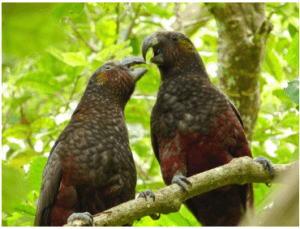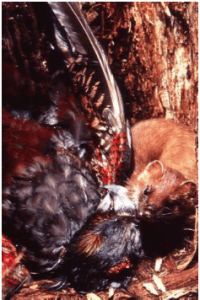Executive Summary
In New Zealand, once called “the land of the birds,” the clearing of forests and introduction of non-native predators severely diminished the variety of endemic wildlife such as the kaka parrot, seen here in Figure 1.
Figure 1: Kaka Parrot (Briggs, 2012)
In the relatively short amount of time that human settlers have inhabited New Zealand, they have had an irreversible impact on the region’s indigenous wildlife. The consequent extinction of hundreds of native species has led to the deterioration of intricate ecosystems that took billions of years to evolve. As a tribute to the fallen species and to preserve remaining wildlife, Zealandia Wildlife Sanctuary aspires to recreate the expansive native plant and bird life that humans first encountered within the once mammal-free land. However, as thriving bird species such as the kaka parrot expand beyond the sanctuary’s safe perimeter, they are encountering an urban environment.
In what used to be their native habitat, kaka are now susceptible to new threats. The introduction of predators such as stoats, rats, and possums, threaten the kaka population (Figure 2).
Figure 2: Stoat Attacking a Kaka (Untitled … Kaka, n.d.)
Furthermore, as they expand into what is now an urban environment, this bird population is increasingly preyed upon by domestic cats. Additionally, kaka traveling outside of the sanctuary are exposed to toxic substances on houses, such as lead and arsenic. The reintroduction of native bird species in their backyards has captivated the interest of the communities surrounding the sanctuary, but the consequent interactions have proven sometimes dangerous to kaka and potentially negative for residents. One common issue associated with these interactions includes many residents’ limited awareness of kaka’s diet. In their desire to connect with nature, residents often feed the bird inappropriate foods (Figure 3), causing malnutrition and developmental deformities.
Figure 3: Kaka Being Fed
Additionally, the increased presence of kaka on residential properties has resulted in roof, deck, and tree damage for some residents. These adverse impacts on both birds and residents have led to concern regarding kaka’s expansion into the suburbs surrounding the sanctuary.
Methodology
Findings & Analysis
Recommendations
Conclusion
Methodology
The goal of our project was to evaluate the interactions between Wellington residents and kaka by assessing the community attitudes and behaviors toward the parrot. To achieve this goal, we initially carried out a site assessment of the sanctuary and the surrounding suburbs. We determined what locations were most suitable for our study by visiting the suburbs bordering the sanctuary. In this way, we identified accessible locations with the highest potential for human and kaka interactions outside of the sanctuary to include in our research. We used this information to create a target map, distributing surveys to the areas we deemed most relevant. To collect as many responses as possible, we provided an option for residents to fill out either a paper or online survey. Our survey questions focused on collecting data on residents’ interactions with kaka, including how often they see the birds and whether or not they feed them. To further our understanding of such interactions, we conducted a series of three focus groups with residents who expressed on the survey their willingness to participate. These focus groups fostered dynamic discussions about the residents’ experiences with kaka and their attitudes towards the birds, providing our team with more in-depth information than the survey results alone. In addition, we conducted interviews with residents who expressed interest but were unable to attend a focus group. Through these strategies, we gathered the appropriate information to explore the complex relationship between kaka, residents surrounding the sanctuary, and their engagement with Zealandia’s mission.
Findings and Analysis
Through our assessment of the neighborhoods surrounding Zealandia, we chose to survey parts of the suburbs Karori and Highbury that fell within about four blocks of the sanctuary. We distributed approximately 1000 surveys and subsequently collected 202 responses. From these survey results, we determined that the vast majority of the residents who participated enjoy having kaka on their property, often in spite of tree and property damage. There was a largely positive response from residents regarding the recovering native bird populations, and there seemed to be much support for Zealandia’s mission. However, the results from both the survey and the focus groups suggested a general lack of awareness about kaka’s habits, diet, and threats that they face. Many residents also were unfamiliar with the details of Zealandia’s conservation efforts. A large number of the residents from whom we received feedback expressed great interest in learning more about both kaka and Zealandia, and were eager to become more actively involved in conserving native wildlife.
The analysis of our findings provided insight into the dynamics of Zealandia’s mission and its relationship with the community surrounding the sanctuary. It seems that residents are supportive of Zealandia’s mission and enthusiastic about preserving native wildlife. They are also highly receptive to receiving information and learning more about kaka and measures they can take to improve their relationship with the birds. However, some residents also expressed feelings of detachment from the sanctuary. For the most part, they seemed unaware of the ample information provided on Zealandia’s website, and suggested that they would be more engaged if the sanctuary reached out to the community with such information. Residents also expressed uncertainty about Zealandia’s views on interactions with kaka, but felt that they would be more interested or willing to follow it if Zealandia actively promoted a consistent stance. In this way, residents have positive views toward interacting with kaka and are supportive of Zealandia’s efforts, but feel that they are slightly disconnected from the sanctuary and unsure of how to access further information.
Recommendations
In accordance with our findings and analysis, we developed a series of recommendations for ways Zealandia can improve interactions between residents and kaka and extend its relationship with volunteers and the community, as well as designed potential tools for implementation of these recommendations. We believe that the residents’ positive attitude toward kaka will make them more receptive to additional information on ways to interact safely. In addition, both residents and the sanctuary would benefit from enhanced information flow and outreach. Increased feedback and more reported kaka sightings would be useful to Zealandia, and further information or engagement could enable residents to feel more connected to the sanctuary’s mission. Many of these recommendations were developed on the basis of recurring topics and feedback received from the focus groups and interviews. The residents were excited to share their ideas in hopes of becoming more involved with Zealandia’s endeavor to help kaka and other native birds. We found that volunteers are passionate about Zealandia’s mission, and residents feel privileged to have native birds in their backyards. In developing these recommendations, we took into account several areas of residential behaviors, attitudes, and interactions that we believe could be addressed:
We recommend that Zealandia provide and promote a set of guidelines and information on kaka to encourage safe interactions between residents and the birds.
To achieve this, we recommend specifically that Zealandia be consistent in promoting its stance about feeding, and also provide further information to ensure that continued interactions are not detrimental to kaka. Furthermore, we recommend that Zealandia collaborate with residents on ways the residents can improve their property to be more kaka-friendly. In addition, we recommend that the sanctuary expand and promote its information about the dangers kaka face due to predation by cats. Zealandia might also consider making several changes to the format of its website. Making the important topics prominent on the website could be an effective way to provide the community with a “go to” resource if they seek more information.
We recommend that Zealandia enhance its outreach and communication with volunteers and the community.
To accomplish this, we recommend that Zealandia implement changes to existing practices. Enhancing use of free media coverage and making news from the sanctuary more engaging could help increase residents’ and other visitors’ interest in Zealandia and its mission. Another suggestion is to visit neighboring schools and hold an educational program. Furthermore, creating a “Sponsor a Kaka” program could be a way for Zealandia to encourage smaller donations, increase community involvement, and help continue the sanctuary’s programs. Finally, we feel that continuing and expanding its banding practices would be beneficial to Zealandia’s endeavors.
Conclusion
Mitigating and monitoring community attitudes and behaviors are especially important in this situation because the kaka populations are expanding into an urban environment where interactions with residents are inevitable. Due to the irreversible negative impact that humans and the predators they introduced have had on native bird species, it is important that present-day residents be educated and made acutely aware of measures they can take to preserve existing native wildlife. Many residents have requested this as well. Similarly, engaging and reaching out to residents is vital to their understanding and support for the mission of Zealandia and the restoration of native New Zealand bird species. Including residents in these efforts will make the process of restoration easier for Zealandia and may support the reemergence of native wildlife in the Greater Wellington region.





